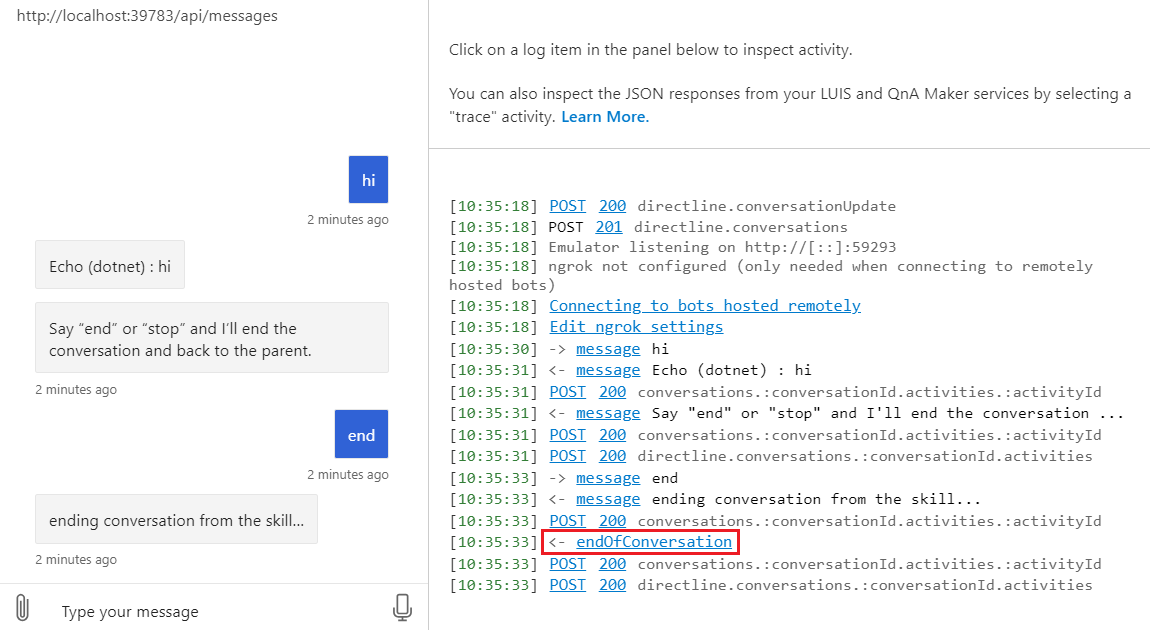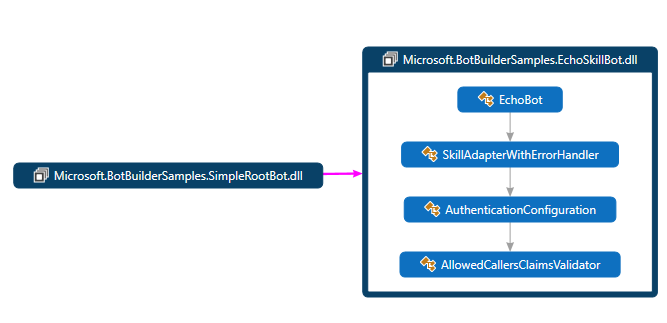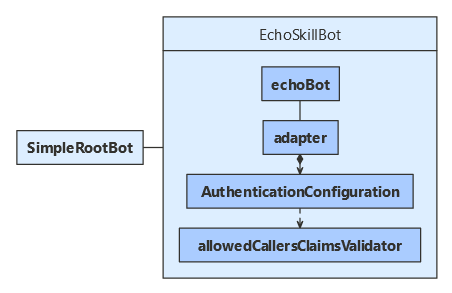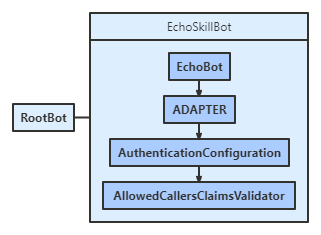APPLIES TO: SDK v4
You can use skills to extend another bot.
A skill is a bot that can perform a set of tasks for another bot.
- A manifest describes a skill's interface. Developers who don't have access to the skill's source code can use the information in the manifest to design their skill consumer.
- A skill can use claims validation to manage which bots or users can access it.
This article demonstrates how to implement a skill that echoes the user's input.
Some types of skill consumers are not able to use some types of skill bots.
The following table describes which combinations are supported.
| |
Multi-tenant skill |
Single-tenant skill |
User-assigned managed identity skill |
| Multi-tenant consumer |
Supported |
Not supported |
Not supported |
| Single-tenant consumer |
Not supported |
Supported if both apps belong to same tenant |
Supported if both apps belong to same tenant |
| User-assigned managed identity consumer |
Not supported |
Supported if both apps belong to same tenant |
Supported if both apps belong to same tenant |
Note
The Bot Framework JavaScript, C#, and Python SDKs will continue to be supported, however, the Java SDK is being retired with final long-term support ending in November 2023.
Existing bots built with the Java SDK will continue to function.
For new bot building, read about choosing the right copilot solution.
For more information, see The future of bot building.
Prerequisites
Note
Starting with version 4.11, you don't need an app ID and password to test a skill locally in the Bot Framework Emulator. An Azure subscription is still required to deploy your skill to Azure.
About this sample
The skills simple bot-to-bot sample includes projects for two bots:
- The echo skill bot, which implements the skill.
- The simple root bot, which implements a root bot that consumes the skill.
This article focuses on the skill, which includes support logic in its bot and adapter.
For information about the simple root bot, see how to Implement a skill consumer.
Resources
For deployed bots, bot-to-bot authentication requires that each participating bot has valid identity information.
However, you can test multitenant skills and skill consumers locally with the Emulator without an app ID and password.
To make the skill available to user-facing bots, register the skill with Azure. For more information, see how to register a bot with Azure AI Bot Service.
Application configuration
Optionally, add the skill's identity information to its configuration file. If either the skill or skill consumer provides identity information, both must.
The allowed callers array can restrict which skill consumers can access the skill.
To accept calls from any skill consumer, add an "*" element.
Note
If you're testing your skill locally without bot identity information, neither the skill nor the skill consumer run the code to perform claims validation.
EchoSkillBot\appsettings.json
Optionally, add the skill's identity information to the appsettings.json file.
{
"MicrosoftAppType": "",
"MicrosoftAppId": "",
"MicrosoftAppPassword": "",
"MicrosoftAppTenantId": "",
// This is a comma separate list with the App IDs that will have access to the skill.
// This setting is used in AllowedCallersClaimsValidator.
// Examples:
// [ "*" ] allows all callers.
// [ "AppId1", "AppId2" ] only allows access to parent bots with "AppId1" and "AppId2".
"AllowedCallers": [ "*" ]
}
echo-skill-bot/.env
Optionally, add the skill's identity information to the .env file.
MicrosoftAppType=
MicrosoftAppId=
MicrosoftAppPassword=
MicrosoftAppTenantId=
AllowedCallers=*
DialogSkillBot\resources\application.properties
Optionally, add the skill's app ID and password to the application.properties file.
MicrosoftAppId=
MicrosoftAppPassword=
server.port=39783
# This is a comma separate list with the App IDs that will have access to the skill.
# This setting is used in AllowedCallersClaimsValidator.
# Examples:
# * allows all callers.
# AppId1,AppId2 only allows access to parent bots with "AppId1" and "AppId2".
AllowedCallers=*
Optionally, add the skill's app ID and password to the config.py file.
config.py
APP_ID = os.environ.get("MicrosoftAppId", "")
APP_PASSWORD = os.environ.get("MicrosoftAppPassword", "")
APP_TYPE = os.environ.get("MicrosoftAppType", "MultiTenant")
APP_TENANTID = os.environ.get("MicrosoftAppTenantId", "")
# Callers to only those specified, '*' allows any caller.
Activity handler logic
The skill consumer can send information to the skill. One way to accept such information is to accept them via the value property on incoming messages. Another way is to handle event and invoke activities.
The skill in this example doesn't accept input parameters.
To continue or complete a conversation
When the skill sends an activity, the skill consumer should forward the activity on to the user.
However, you need to send an endOfConversation activity when the skill finishes; otherwise, the skill consumer continues to forward user activities to the skill.
Optionally, use the activity's value property to include a return value, and use the activity's code property to indicate why the skill is ending.
EchoSkillBot\Bots\EchoBot.cs
protected override async Task OnMessageActivityAsync(ITurnContext<IMessageActivity> turnContext, CancellationToken cancellationToken)
{
if (turnContext.Activity.Text.Contains("end") || turnContext.Activity.Text.Contains("stop"))
{
// Send End of conversation at the end.
var messageText = $"ending conversation from the skill...";
await turnContext.SendActivityAsync(MessageFactory.Text(messageText, messageText, InputHints.IgnoringInput), cancellationToken);
var endOfConversation = Activity.CreateEndOfConversationActivity();
endOfConversation.Code = EndOfConversationCodes.CompletedSuccessfully;
await turnContext.SendActivityAsync(endOfConversation, cancellationToken);
}
else
{
var messageText = $"Echo: {turnContext.Activity.Text}";
await turnContext.SendActivityAsync(MessageFactory.Text(messageText, messageText, InputHints.IgnoringInput), cancellationToken);
messageText = "Say \"end\" or \"stop\" and I'll end the conversation and back to the parent.";
await turnContext.SendActivityAsync(MessageFactory.Text(messageText, messageText, InputHints.ExpectingInput), cancellationToken);
}
}
echo-skill-bot/bot.js
this.onMessage(async (context, next) => {
switch (context.activity.text.toLowerCase()) {
case 'end':
case 'stop':
await context.sendActivity({
type: ActivityTypes.EndOfConversation,
code: EndOfConversationCodes.CompletedSuccessfully
});
break;
default:
await context.sendActivity(`Echo (JS) : '${ context.activity.text }'`);
await context.sendActivity('Say "end" or "stop" and I\'ll end the conversation and back to the parent.');
}
// By calling next() you ensure that the next BotHandler is run.
await next();
});
echoSkillBot\EchoBot.java
protected CompletableFuture<Void> onMessageActivity(TurnContext turnContext) {
if (
turnContext.getActivity().getText().contains("end") || turnContext.getActivity().getText().contains("stop")
) {
String messageText = "ending conversation from the skill...";
return turnContext.sendActivity(MessageFactory.text(messageText, messageText, InputHints.IGNORING_INPUT))
.thenApply(result -> {
Activity endOfConversation = Activity.createEndOfConversationActivity();
endOfConversation.setCode(EndOfConversationCodes.COMPLETED_SUCCESSFULLY);
return turnContext.sendActivity(endOfConversation);
})
.thenApply(finalResult -> null);
} else {
String messageText = String.format("Echo: %s", turnContext.getActivity().getText());
return turnContext.sendActivity(MessageFactory.text(messageText, messageText, InputHints.IGNORING_INPUT))
.thenApply(result -> {
String nextMessageText =
"Say \"end\" or \"stop\" and I'll end the conversation and back to the parent.";
return turnContext.sendActivity(
MessageFactory.text(nextMessageText, nextMessageText, InputHints.EXPECTING_INPUT)
);
})
.thenApply(result -> null);
}
}
echo-skill-bot/bots/echo_bot.py
async def on_message_activity(self, turn_context: TurnContext):
if "end" in turn_context.activity.text or "stop" in turn_context.activity.text:
# Send End of conversation at the end.
await turn_context.send_activity(
MessageFactory.text("Ending conversation from the skill...")
)
end_of_conversation = Activity(type=ActivityTypes.end_of_conversation)
end_of_conversation.code = EndOfConversationCodes.completed_successfully
await turn_context.send_activity(end_of_conversation)
else:
await turn_context.send_activity(
MessageFactory.text(f"Echo (python): {turn_context.activity.text}")
)
await turn_context.send_activity(
MessageFactory.text(
f'Say "end" or "stop" and I\'ll end the conversation and back to the parent.'
)
)
To cancel the skill
For multi-turn skills, you would also accept endOfConversation activities from a skill consumer, to allow the consumer to cancel the current conversation.
The logic for this skill doesn't change from turn to turn. If you implement a skill that allocates conversation resources, add resource cleanup code to the end-of-conversation handler.
EchoSkillBot\Bots\EchoBot.cs
protected override Task OnEndOfConversationActivityAsync(ITurnContext<IEndOfConversationActivity> turnContext, CancellationToken cancellationToken)
{
// This will be called if the root bot is ending the conversation. Sending additional messages should be
// avoided as the conversation may have been deleted.
// Perform cleanup of resources if needed.
return Task.CompletedTask;
}
echo-skill-bot/bot.js
Use the onUnrecognizedActivityType method to add an end-of-conversation logic. In the handler, check whether the unrecognized activity's type equals endOfConversation.
this.onEndOfConversation(async (context, next) => {
// This will be called if the root bot is ending the conversation. Sending additional messages should be
// avoided as the conversation may have been deleted.
// Perform cleanup of resources if needed.
// By calling next() you ensure that the next BotHandler is run.
await next();
});
echoSkillBot\EchoBot.java
protected CompletableFuture<Void> onEndOfConversationActivity(TurnContext turnContext) {
// This will be called if the root bot is ending the conversation. Sending
// additional messages should be
// avoided as the conversation may have been deleted.
// Perform cleanup of resources if needed.
return CompletableFuture.completedFuture(null);
}
echo-skill-bot/bots/echo_bot.py
async def on_end_of_conversation_activity(self, turn_context: TurnContext):
# This will be called if the root bot is ending the conversation. Sending additional messages should be
# avoided as the conversation may have been deleted.
# Perform cleanup of resources if needed.
pass
Claims validator
This sample uses an allowed callers list for claims validation. The skill's configuration file defines the list. The validator object then reads the list.
You must add a claims validator to the authentication configuration. The claims are evaluated after the authentication header. Your validation code should throw an error or exception to reject the request. There are many reasons you might want to reject an otherwise authenticated request. For example:
- The skill is part of a paid-for service. User's not in the database shouldn't have access.
- The skill is proprietary. Only certain skill consumers can call the skill.
Important
If you don't provide a claims validator, your bot will generate an error or exception upon receiving an activity from the skill consumer.
The SDK provides an AllowedCallersClaimsValidator class that adds application-level authorization based on a simple list of IDs of the applications that are allowed to call the skill. If the list contains an asterisk (*), then all callers are allowed. The claims validator is configured in Startup.cs.
The SDK provides an allowedCallersClaimsValidator class that adds application-level authorization based on a simple list of IDs of the applications that are allowed to call the skill. If the list contains an asterisk (*), then all callers are allowed. The claims validator is configured in index.js.
The SDK provides an AllowedCallersClaimsValidator class that adds application-level authorization based on a simple list of IDs of the applications that are allowed to call the skill. If the list contains an asterisk (*), then all callers are allowed. The claims validator is configured in Application.java.
Define a claims validation method that throws an error to reject an incoming request.
echo-skill-bot/authentication/allowed_callers_claims_validator.py
class AllowedCallersClaimsValidator:
config_key = "ALLOWED_CALLERS"
def __init__(self, config: DefaultConfig):
if not config:
raise TypeError(
"AllowedCallersClaimsValidator: config object cannot be None."
)
# ALLOWED_CALLERS is the setting in config.py file
# that consists of the list of parent bot ids that are allowed to access the skill
# to add a new parent bot simply go to the AllowedCallers and add
# the parent bot's microsoft app id to the list
caller_list = getattr(config, self.config_key)
if caller_list is None:
raise TypeError(f'"{self.config_key}" not found in configuration.')
self._allowed_callers = frozenset(caller_list)
@property
def claims_validator(self) -> Callable[[List[Dict]], Awaitable]:
async def allow_callers_claims_validator(claims: Dict[str, object]):
# if allowed_callers is None we allow all calls
if "*" not in self._allowed_callers and SkillValidation.is_skill_claim(
claims
):
# Check that the appId claim in the skill request is in the list of skills configured for this bot.
app_id = JwtTokenValidation.get_app_id_from_claims(claims)
if app_id not in self._allowed_callers:
raise PermissionError(
f'Received a request from a bot with an app ID of "{app_id}".'
f" To enable requests from this caller, add the app ID to your configuration file."
)
return
return allow_callers_claims_validator
Skill adapter
When an error occurs, the skill's adapter should clear conversation state for the skill, and it should also send an endOfConversation activity to the skill consumer. To signal that the skill ended due to an error, use the code property of the activity.
EchoSkillBot\SkillAdapterWithErrorHandler.cs
private async Task HandleTurnError(ITurnContext turnContext, Exception exception)
{
// Log any leaked exception from the application.
_logger.LogError(exception, $"[OnTurnError] unhandled error : {exception.Message}");
await SendErrorMessageAsync(turnContext, exception);
await SendEoCToParentAsync(turnContext, exception);
}
private async Task SendErrorMessageAsync(ITurnContext turnContext, Exception exception)
{
try
{
// Send a message to the user.
var errorMessageText = "The skill encountered an error or bug.";
var errorMessage = MessageFactory.Text(errorMessageText, errorMessageText, InputHints.IgnoringInput);
await turnContext.SendActivityAsync(errorMessage);
errorMessageText = "To continue to run this bot, please fix the bot source code.";
errorMessage = MessageFactory.Text(errorMessageText, errorMessageText, InputHints.ExpectingInput);
await turnContext.SendActivityAsync(errorMessage);
// Send a trace activity, which will be displayed in the Bot Framework Emulator.
// Note: we return the entire exception in the value property to help the developer;
// this should not be done in production.
await turnContext.TraceActivityAsync("OnTurnError Trace", exception.ToString(), "https://www.botframework.com/schemas/error", "TurnError");
}
catch (Exception ex)
{
_logger.LogError(ex, $"Exception caught in SendErrorMessageAsync : {ex}");
}
}
private async Task SendEoCToParentAsync(ITurnContext turnContext, Exception exception)
{
try
{
// Send an EndOfConversation activity to the skill caller with the error to end the conversation,
// and let the caller decide what to do.
var endOfConversation = Activity.CreateEndOfConversationActivity();
endOfConversation.Code = "SkillError";
endOfConversation.Text = exception.Message;
await turnContext.SendActivityAsync(endOfConversation);
}
catch (Exception ex)
{
_logger.LogError(ex, $"Exception caught in SendEoCToParentAsync : {ex}");
}
}
echo-skill-bot/index.js
// Catch-all for errors.
adapter.onTurnError = async (context, error) => {
// This check writes out errors to the console log, instead of to app insights.
// NOTE: In a production environment, you should consider logging this to Azure
// application insights.
console.error(`\n [onTurnError] unhandled error: ${ error }`);
await sendErrorMessage(context, error);
await sendEoCToParent(context, error);
};
async function sendErrorMessage(context, error) {
try {
// Send a message to the user.
let onTurnErrorMessage = 'The skill encountered an error or bug.';
await context.sendActivity(onTurnErrorMessage, onTurnErrorMessage, InputHints.ExpectingInput);
onTurnErrorMessage = 'To continue to run this bot, please fix the bot source code.';
await context.sendActivity(onTurnErrorMessage, onTurnErrorMessage, InputHints.ExpectingInput);
// Send a trace activity, which will be displayed in the Bot Framework Emulator.
// Note: we return the entire exception in the value property to help the developer;
// this should not be done in production.
await context.sendTraceActivity('OnTurnError Trace', error.toString(), 'https://www.botframework.com/schemas/error', 'TurnError');
} catch (err) {
console.error(`\n [onTurnError] Exception caught in sendErrorMessage: ${ err }`);
}
}
async function sendEoCToParent(context, error) {
try {
// Send an EndOfConversation activity to the skill caller with the error to end the conversation,
// and let the caller decide what to do.
const endOfConversation = {
type: ActivityTypes.EndOfConversation,
code: 'SkillError',
text: error.toString()
};
await context.sendActivity(endOfConversation);
} catch (err) {
console.error(`\n [onTurnError] Exception caught in sendEoCToParent: ${ err }`);
}
}
echoSkillBot\SkillAdapterWithErrorHandler.java
public SkillAdapterWithErrorHandler(
Configuration configuration,
AuthenticationConfiguration authenticationConfiguration
) {
super(configuration, authenticationConfiguration);
setOnTurnError(new SkillAdapterErrorHandler());
}
private class SkillAdapterErrorHandler implements OnTurnErrorHandler {
@Override
public CompletableFuture<Void> invoke(TurnContext turnContext, Throwable exception) {
return sendErrorMessage(turnContext, exception).thenAccept(result -> {
sendEoCToParent(turnContext, exception);
});
}
private CompletableFuture<Void> sendErrorMessage(TurnContext turnContext, Throwable exception) {
try {
// Send a message to the user.
String errorMessageText = "The skill encountered an error or bug.";
Activity errorMessage =
MessageFactory.text(errorMessageText, errorMessageText, InputHints.IGNORING_INPUT);
return turnContext.sendActivity(errorMessage).thenAccept(result -> {
String secondLineMessageText = "To continue to run this bot, please fix the bot source code.";
Activity secondErrorMessage =
MessageFactory.text(secondLineMessageText, secondLineMessageText, InputHints.EXPECTING_INPUT);
turnContext.sendActivity(secondErrorMessage)
.thenApply(
sendResult -> {
// Send a trace activity, which will be displayed in the Bot Framework Emulator.
// Note: we return the entire exception in the value property to help the
// developer;
// this should not be done in production.
return TurnContext.traceActivity(
turnContext,
String.format("OnTurnError Trace %s", exception.toString())
);
}
);
});
} catch (Exception ex) {
return Async.completeExceptionally(ex);
}
}
private CompletableFuture<Void> sendEoCToParent(TurnContext turnContext, Throwable exception) {
try {
// Send an EndOfConversation activity to the skill caller with the error to end
// the conversation,
// and let the caller decide what to do.
Activity endOfConversation = Activity.createEndOfConversationActivity();
endOfConversation.setCode(EndOfConversationCodes.SKILL_ERROR);
endOfConversation.setText(exception.getMessage());
return turnContext.sendActivity(endOfConversation).thenApply(result -> null);
} catch (Exception ex) {
return Async.completeExceptionally(ex);
}
}
}
echo-skill-bot/adapter_with_error_handler.py
# This check writes out errors to console log
# NOTE: In production environment, you should consider logging this to Azure
# application insights.
print(f"\n [on_turn_error] unhandled error: {error}", file=sys.stderr)
traceback.print_exc()
await self._send_error_message(turn_context, error)
await self._send_eoc_to_parent(turn_context, error)
async def _send_error_message(self, turn_context: TurnContext, error: Exception):
try:
# Send a message to the user.
error_message_text = "The skill encountered an error or bug."
error_message = MessageFactory.text(
error_message_text, error_message_text, InputHints.ignoring_input
)
await turn_context.send_activity(error_message)
error_message_text = (
"To continue to run this bot, please fix the bot source code."
)
error_message = MessageFactory.text(
error_message_text, error_message_text, InputHints.ignoring_input
)
await turn_context.send_activity(error_message)
# Send a trace activity, which will be displayed in Bot Framework Emulator.
await turn_context.send_trace_activity(
label="TurnError",
name="on_turn_error Trace",
value=f"{error}",
value_type="https://www.botframework.com/schemas/error",
)
except Exception as exception:
print(
f"\n Exception caught on _send_error_message : {exception}",
file=sys.stderr,
)
traceback.print_exc()
async def _send_eoc_to_parent(self, turn_context: TurnContext, error: Exception):
try:
# Send an EndOfConversation activity to the skill caller with the error to end the conversation,
# and let the caller decide what to do.
end_of_conversation = Activity(type=ActivityTypes.end_of_conversation)
end_of_conversation.code = "SkillError"
end_of_conversation.text = str(error)
await turn_context.send_activity(end_of_conversation)
except Exception as exception:
print(
f"\n Exception caught on _send_eoc_to_parent : {exception}",
file=sys.stderr,
)
traceback.print_exc()
Service registration
The Bot Framework adapter uses an authentication configuration object (set when the adapter is created) to validate the authentication header on incoming requests.
This sample adds claims validation to the authentication configuration and uses the skill adapter with error handler described in the previous section.
EchoSkillBot\Startup.cs
options.SerializerSettings.MaxDepth = HttpHelper.BotMessageSerializerSettings.MaxDepth;
});
// Register AuthConfiguration to enable custom claim validation.
services.AddSingleton(sp =>
{
var allowedCallers = new List<string>(sp.GetService<IConfiguration>().GetSection("AllowedCallers").Get<string[]>());
var claimsValidator = new AllowedCallersClaimsValidator(allowedCallers);
// If TenantId is specified in config, add the tenant as a valid JWT token issuer for Bot to Skill conversation.
// The token issuer for MSI and single tenant scenarios will be the tenant where the bot is registered.
var validTokenIssuers = new List<string>();
var tenantId = sp.GetService<IConfiguration>().GetSection(MicrosoftAppCredentials.MicrosoftAppTenantIdKey)?.Value;
if (!string.IsNullOrWhiteSpace(tenantId))
{
// For SingleTenant/MSI auth, the JWT tokens will be issued from the bot's home tenant.
// Therefore, these issuers need to be added to the list of valid token issuers for authenticating activity requests.
validTokenIssuers.Add(string.Format(CultureInfo.InvariantCulture, AuthenticationConstants.ValidTokenIssuerUrlTemplateV1, tenantId));
validTokenIssuers.Add(string.Format(CultureInfo.InvariantCulture, AuthenticationConstants.ValidTokenIssuerUrlTemplateV2, tenantId));
validTokenIssuers.Add(string.Format(CultureInfo.InvariantCulture, AuthenticationConstants.ValidGovernmentTokenIssuerUrlTemplateV1, tenantId));
validTokenIssuers.Add(string.Format(CultureInfo.InvariantCulture, AuthenticationConstants.ValidGovernmentTokenIssuerUrlTemplateV2, tenantId));
}
return new AuthenticationConfiguration
{
ClaimsValidator = claimsValidator,
ValidTokenIssuers = validTokenIssuers
};
});
// Create the Bot Framework Authentication to be used with the Bot Adapter.
services.AddSingleton<BotFrameworkAuthentication, ConfigurationBotFrameworkAuthentication>();
echo-skill-bot/index.js
const allowedCallers = (process.env.AllowedCallers || '').split(',').filter((val) => val) || [];
const claimsValidators = allowedCallersClaimsValidator(allowedCallers);
// If the MicrosoftAppTenantId is specified in the environment config, add the tenant as a valid JWT token issuer for Bot to Skill conversation.
// The token issuer for MSI and single tenant scenarios will be the tenant where the bot is registered.
let validTokenIssuers = [];
const { MicrosoftAppTenantId } = process.env;
if (MicrosoftAppTenantId) {
// For SingleTenant/MSI auth, the JWT tokens will be issued from the bot's home tenant.
// Therefore, these issuers need to be added to the list of valid token issuers for authenticating activity requests.
validTokenIssuers = [
`${ AuthenticationConstants.ValidTokenIssuerUrlTemplateV1 }${ MicrosoftAppTenantId }/`,
`${ AuthenticationConstants.ValidTokenIssuerUrlTemplateV2 }${ MicrosoftAppTenantId }/v2.0/`,
`${ AuthenticationConstants.ValidGovernmentTokenIssuerUrlTemplateV1 }${ MicrosoftAppTenantId }/`,
`${ AuthenticationConstants.ValidGovernmentTokenIssuerUrlTemplateV2 }${ MicrosoftAppTenantId }/v2.0/`
];
}
// Define our authentication configuration.
const authConfig = new AuthenticationConfiguration([], claimsValidators, validTokenIssuers);
const credentialsFactory = new ConfigurationServiceClientCredentialFactory({
MicrosoftAppId: process.env.MicrosoftAppId,
MicrosoftAppPassword: process.env.MicrosoftAppPassword,
MicrosoftAppType: process.env.MicrosoftAppType,
MicrosoftAppTenantId: process.env.MicrosoftAppTenantId
});
const botFrameworkAuthentication = new ConfigurationBotFrameworkAuthentication(process.env, credentialsFactory, authConfig);
// Create adapter.
// See https://aka.ms/about-bot-adapter to learn more about how bots work.
const adapter = new CloudAdapter(botFrameworkAuthentication);
echoSkillBot\Application.java
@Override
public AuthenticationConfiguration getAuthenticationConfiguration(Configuration configuration) {
AuthenticationConfiguration authenticationConfiguration = new AuthenticationConfiguration();
authenticationConfiguration.setClaimsValidator(
new AllowedCallersClaimsValidator(Arrays.asList(configuration.getProperties(configKey)))
);
return authenticationConfiguration;
}
echo-skill-bot/app.py
CLAIMS_VALIDATOR = AllowedCallersClaimsValidator(CONFIG)
AUTH_CONFIG = AuthenticationConfiguration(
claims_validator=CLAIMS_VALIDATOR.claims_validator
)
# Create adapter.
# See https://aka.ms/about-bot-adapter to learn more about how bots work.
SETTINGS = ConfigurationBotFrameworkAuthentication(
CONFIG,
auth_configuration=AUTH_CONFIG,
)
ADAPTER = AdapterWithErrorHandler(SETTINGS)
Skill manifest
A skill manifest is a JSON file that describes the activities the skill can perform, its input and output parameters, and the skill's endpoints.
The manifest contains the information you need to access the skill from another bot.
The latest schema version is v2.1.
EchoSkillBot\wwwroot\manifest\echoskillbot-manifest-1.0.json
{
"$schema": "https://schemas.botframework.azure.cn/schemas/skills/skill-manifest-2.0.0.json",
"$id": "EchoSkillBot",
"name": "Echo Skill bot",
"version": "1.0",
"description": "This is a sample echo skill",
"publisherName": "Microsoft",
"privacyUrl": "https://echoskillbot.contoso.com/privacy.html",
"copyright": "Copyright (c) Microsoft Corporation. All rights reserved.",
"license": "",
"iconUrl": "https://echoskillbot.contoso.com/icon.png",
"tags": [
"sample",
"echo"
],
"endpoints": [
{
"name": "default",
"protocol": "BotFrameworkV3",
"description": "Default endpoint for the skill",
"endpointUrl": "http://echoskillbot.contoso.com/api/messages",
"msAppId": "00000000-0000-0000-0000-000000000000"
}
]
}
echo-skill-bot/manifest/echoskillbot-manifest-1.0.json
{
"$schema": "https://schemas.botframework.azure.cn/schemas/skills/skill-manifest-2.0.0.json",
"$id": "EchoSkillBot",
"name": "Echo Skill bot",
"version": "1.0",
"description": "This is a sample echo skill",
"publisherName": "Microsoft",
"privacyUrl": "https://echoskillbot.contoso.com/privacy.html",
"copyright": "Copyright (c) Microsoft Corporation. All rights reserved.",
"license": "",
"iconUrl": "https://echoskillbot.contoso.com/icon.png",
"tags": [
"sample",
"echo"
],
"endpoints": [
{
"name": "default",
"protocol": "BotFrameworkV3",
"description": "Default endpoint for the skill",
"endpointUrl": "http://echoskillbot.contoso.com/api/messages",
"msAppId": "00000000-0000-0000-0000-000000000000"
}
]
}
DialogSkillBot\webapp\manifest\echoskillbot-manifest-1.0.json
{
"$schema": "https://schemas.botframework.azure.cn/schemas/skills/skill-manifest-2.0.0.json",
"$id": "EchoSkillBot",
"name": "Echo Skill bot",
"version": "1.0",
"description": "This is a sample echo skill",
"publisherName": "Microsoft",
"privacyUrl": "https://echoskillbot.contoso.com/privacy.html",
"copyright": "Copyright (c) Microsoft Corporation. All rights reserved.",
"license": "",
"iconUrl": "https://echoskillbot.contoso.com/icon.png",
"tags": [
"sample",
"echo"
],
"endpoints": [
{
"name": "default",
"protocol": "BotFrameworkV3",
"description": "Default endpoint for the skill",
"endpointUrl": "http://echoskillbot.contoso.com/api/messages",
"msAppId": "00000000-0000-0000-0000-000000000000"
}
]
}
echo_skill_bot/wwwroot/manifest/echoskillbot-manifest-1.0.json
{
"$schema": "https://schemas.botframework.azure.cn/schemas/skills/skill-manifest-2.0.0.json",
"$id": "EchoSkillBot",
"name": "Echo Skill bot",
"version": "1.0",
"description": "This is a sample echo skill",
"publisherName": "Microsoft",
"privacyUrl": "https://echoskillbot.contoso.com/privacy.html",
"copyright": "Copyright (c) Microsoft Corporation. All rights reserved.",
"license": "",
"iconUrl": "https://echoskillbot.contoso.com/icon.png",
"tags": [
"sample",
"echo"
],
"endpoints": [
{
"name": "default",
"protocol": "BotFrameworkV3",
"description": "Default endpoint for the skill",
"endpointUrl": "http://echoskillbot.contoso.com/api/messages",
"msAppId": "00000000-0000-0000-0000-000000000000"
}
]
}
The skill manifest schema is a JSON file that describes the schema of the skill manifest. The current schema version is 2.1.0.
Test the skill
At this point, you can test the skill in the Emulator as if it were a normal bot. However, to test it as a skill, you would need to implement a skill consumer.
Download and install the latest Bot Framework Emulator
- Run the echo skill bot locally on your machine. If you need instructions, refer to the
README file for the C#, JavaScript, Java, or Python sample.
- Use the Emulator to test the bot. When you send an "end" or "stop" message to the skill, it sends an
endOfConversation activity in addition to the reply message. The skill sends the endOfConversation activity to indicate the skill is finished.

More about debugging
Since traffic between skills and skill consumers is authenticated, there are extra steps when debugging such bots.
- The skill consumer and all the skills it consumes, directly or indirectly, must be running.
- If the bots are running locally and if any of the bots has an app ID and password, then all bots must have valid IDs and passwords.
- If the bots are all deployed, see how to Debug a bot from any channel using devtunnel.
- If some of the bots are running locally and some are deployed, then see how to Debug a skill or skill consumer.
Otherwise, you can debug a skill consumer or skill much like you debug other bots. For more information, see Debugging a bot and Debug with the Bot Framework Emulator.
Next steps




